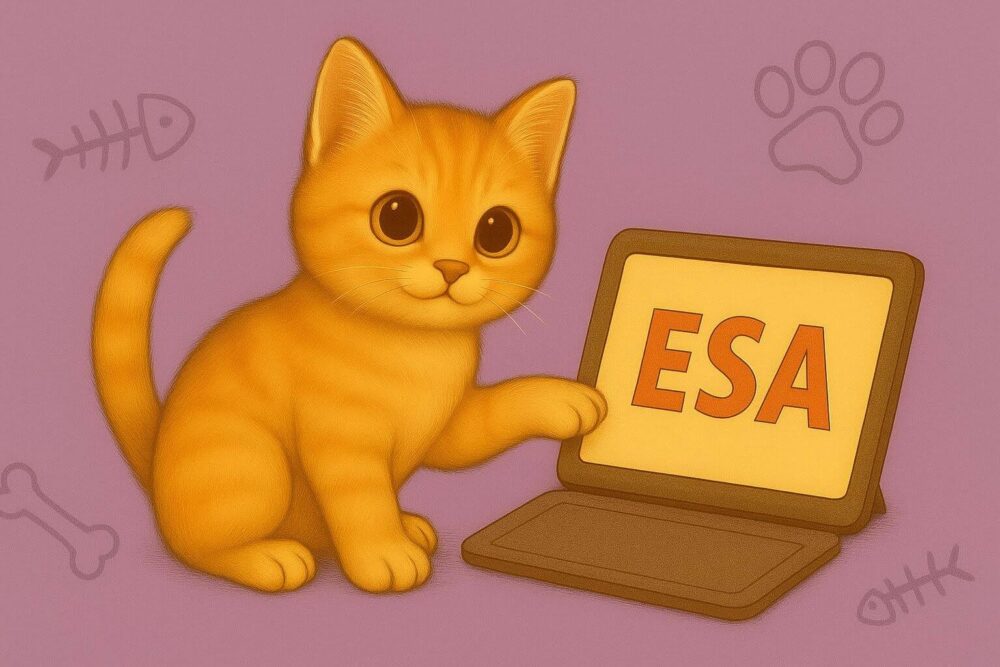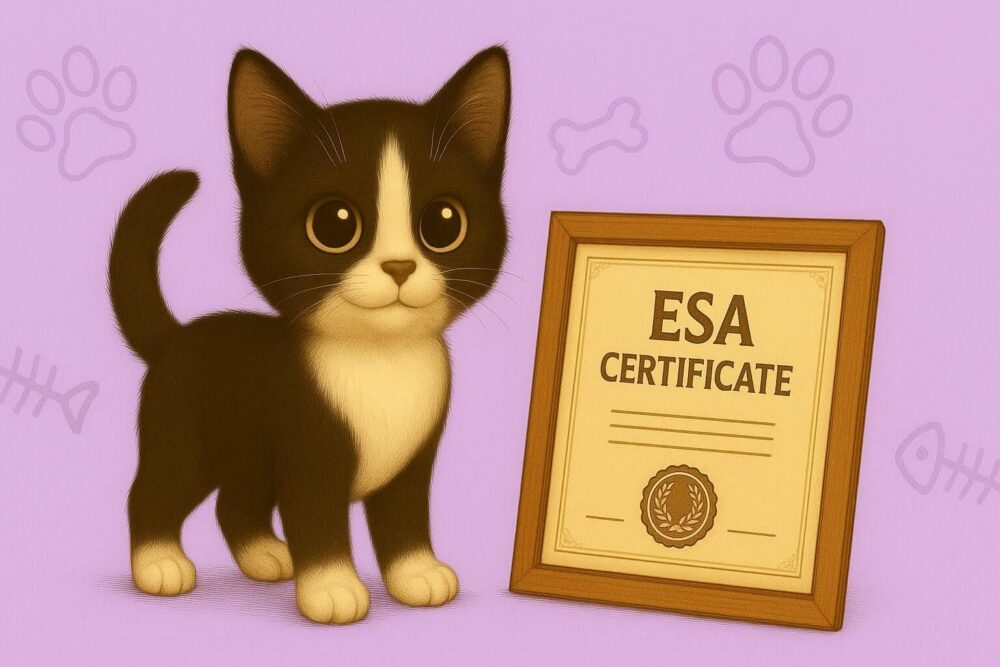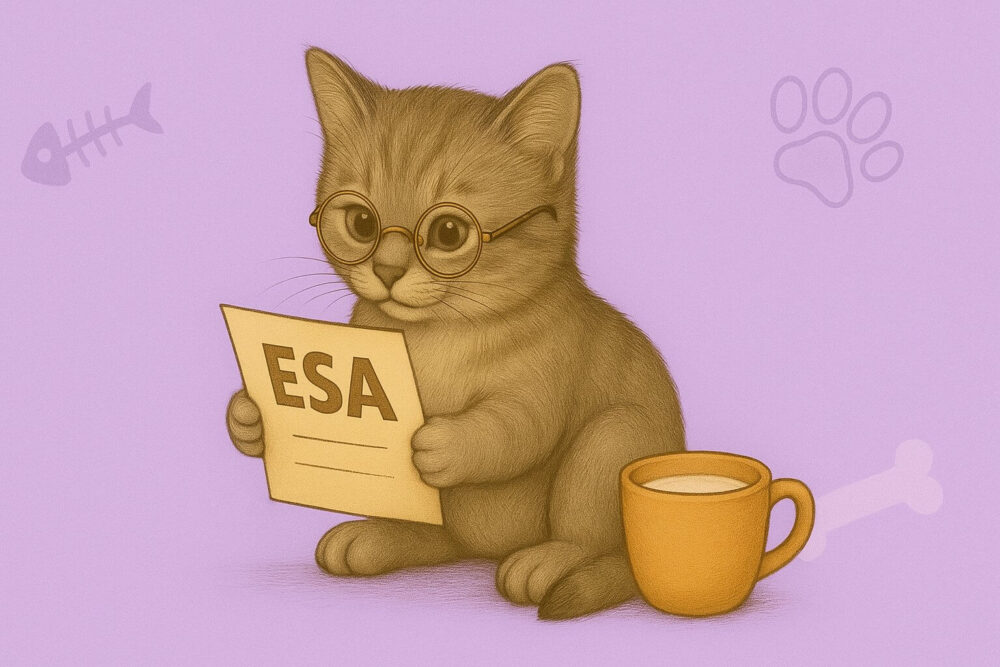
Table of Contents
Your cat might not have a psychology degree, but let’s be honest, they know exactly when you’re about to cry. That uncanny ability to appear at your lowest moments isn’t a coincidence. It’s one of the main reasons cats make incredible emotional support animals.
If you’ve ever Googled “how to make my cat an emotional support animal,” you’ve probably run into confusing advice, outdated info, or just a lot of noise. Most people think this process involves complicated paperwork, expensive fees, or mysterious registration processes. Thankfully, that couldn’t be further away from the truth.
In this guide, we’ll walk you through making your feline therapist an official ESA. You’ll learn what qualifies as an ESA, why cats rock at emotional support, and how to get legitimate documentation.

What Is an Emotional Support Animal?
An emotional support animal is your personal therapist with four paws, sparkly eyes, and a purr that could cure insomnia.
Unlike pets, whose job description could begin and end with “being adorable,” ESAs are legally recognized for their role in easing anxiety, depression, or other mental health challenges. Also, ESAs are prescribed by a licensed mental health professional (LMHP) as part of your treatment plan.
Federal law, specifically the Fair Housing Act (FHA), grants ESAs special protections that make landlords think twice before saying “no pets allowed,” even in pet-free properties. This means:
- No monthly pet rent
- No breed restrictions
- No pet deposits
- No pet limits
How To Make Your Cat an Emotional Support Animal
Just like you can’t declare a fast-food burger a superfood (no matter how therapeutic it feels), you can’t just self-prescribe an ESA, no matter how soothing your cat’s purrs may be.
To have your kitty officially recognized as an ESA, you need the proper documentation, specifically, an ESA letter from a licensed mental health professional. This letter confirms that your cat provides support for a diagnosed mental health condition. To get one, you need to:
- Schedule an appointment with an LMHP
- Complete a mental health evaluation
- Receive your ESA letter if approved
- Present the letter to your landlord
Schedule an Appointment With an LMHP
Only a licensed mental health professional can issue a legally valid ESA letter. That means you’ll need to book time with a:
- Licensed therapist
- Psychologist
- Psychiatrist
- Clinical social worker
- Licensed professional counselor
- Nurse practitioner
Sometimes, primary care doctors can issue these letters, but a mental health specialist is your safest bet. These professionals must be licensed in your state and have experience diagnosing mental health conditions.
Still, finding the right professional can be tricky, especially if local waitlists are long or you’re unsure where to begin. Luckily, online ESA evaluations exist! They’re often faster and can be done from your sofa. Just make sure the provider pairs you with a legit LMHP licensed in your state.
Complete a Mental Health Evaluation
“Mental health evaluation” might sound intimidating, but it’s only a conversation about your mental and emotional well-being. During this conversation, the LMHP assesses whether you have a DSM-5-recognized condition that could be eased by the support of an ESA, such as:
- Anxiety
- Depression
- ADHD
- PTSD
- Autism
- Shizophrenia
- Panic disorders
You can expect basic questions and discussion about your daily life, symptoms, and ways your cat supports your mental health. This is where real-life examples help. For example, you might mention how your cat curls up with you during panic attacks and how that calms you down.
If the LMHP determines that an ESA would benefit your mental health, they will issue a letter. If not, they’ll suggest other forms of support that might help.
Receive Your ESA Letter if Approved
If your LMHP agrees that your cat qualifies as an emotional support animal, you’ll receive an official ESA letter, aka your cat’s golden ticket to housing rights under the FHA. For the letter to hold water legally, it should:
- Be written on the LMPH’s official letterhead
- Include their state license number, National Provider Identifier (NPI), state of practice, and contact details
- Clearly state that you have a qualifying mental health condition
- Explain how your cat helps alleviate symptoms
- Be dated and signed by the LMHP
The letter doesn’t need to specify your cat’s breed, training requirements, or details of your diagnosis.
If anything’s missing or vague, landlords may push back or deny your ESA, so choose a reputable provider and double-check the details.
Present the Letter To Your Landlord
Now that you’ve got your letter in hand, it’s time to share it with your landlord. The FHA requires housing providers to make “reasonable accommodations” for tenants with ESAs, even if their building has a strict “no pets” policy. They must make exceptions to their pet policies to let you move in with your ESA.
If your landlord has any further questions, you can politely refer them to the FHA guidelines. Once presented with proper documentation, most housing providers won’t have a problem with your ESA cozying up to you in your new apartment.
That said, landlords can deny your request in a few specific situations, especially if your cat:
- Has a documented history of aggressive behavior: If Mr. Whiskers has previously scratched other tenants or attacked maintenance workers, that’s a red flag
- Causes significant property damage: If your kitty has shredded the carpets or repeatedly destroyed walls, landlords might use that as grounds for denial
- Places an undue financial or administrative burden: If you’re trying to move into a studio apartment with a dozen cats, expect some pushback

What Makes a Cat Perfect for Emotional Support
Cats may not perform tricks or fetch your meds, but their quiet presence, cozy habits, and gentle routines can do wonders for your mental health. Here’s how your feline friend might be helping more than you realize:
- They create a calming presence
- They pick up on your emotional cues
- They’re low-maintenance, but still affectionate
- They help you build healthy routines
They Create a Calming Presence
If you’ve ever watched a cat nap for hours without a care in the world, you know what peace looks like. But even when they’re awake, they’re cool and calm. They move slowly and graciously, they chill on your lap, and bring tranquility into the room. So, when you’re feeling anxious or overstimulated, that mellow energy can rub off on you.
More importantly, studies show a cat’s purr vibrates at 25–150 Hz, frequencies known to:
- Lower stress hormones
- Reduce blood pressure
- Promote healing
For someone with anxiety or panic attacks, just being near a purring cat can act like a natural reset button.
They Pick Up on Your Emotional Cues
Cats are more in tune with your mood than you might think. If you’re feeling off, sad, stressed, or just not being yourself, they’ll pick up on it. They might stick closer than usual, hang around quietly, even nudge you with a head bump, or curl up beside you and purr.
That said, cats can also be quite active. Playing around with your cat, or at least preventing them from walking on top of your TV, could bring a smile to your face and interrupt depressive episodes.
They’re Low-Maintenance, But Still Affectionate
Cats are chill and low-key. They don’t need walks or endless games of fetch—just food, water, and a clean litter box. And in return, they give you cuddles, company, and purrs that feel like tiny hugs.
For someone with depression or social anxiety, that kind of low-key companionship is crucial. Having a high-maintenance pet can sometimes feel like a chore, and that could bring your mood down, which is the exact opposite of what you need.
They Help You Build Healthy Routines
If your mental health makes organizing your day next to impossible, having a cat might help. Feeding them, cleaning their litter box, and making time for play, even for only 10 minutes a day, can create a sense of routine that transfers to other aspects of your life. And those little bits of structure can add up. For someone with PTSD or depression, inserting little bits of predictability and routine can help bring more structure and stability to their life.
Can You Get a Cat Registered as an Emotional Support Animal?
No, you can’t get a cat registered as an ESA because there’s no such thing as an official ESA registry—not for cats, dogs, hamsters, or any animal. If a website is trying to charge you for registering your emotional support cat in a so-called “national database,” clutch your whiskers, it’s probably a scam.
Similarly, you don’t need an ESA cat certification, ID badge, license number, or a little vest to make your cat legit (though a vest can be cute). As long as you have a valid ESA letter, your cat is legally recognized as your emotional support animal under the FHA.
If you’re looking for an ESA letter for your cat, Your Service Animal can help. The service connects you with LMHPs for a proper mental health consultation. No sketchy “instant approval” forms, no fake registries. Just honest evaluations from qualified professionals who understand ESA laws in your state and can provide the proper paperwork for your emotional support cat.

Why Choose Your Service Animal
Your Service Animal makes the ESA letter process fast, convenient, and fully compliant with federal and state laws, so you can focus on cuddles instead of confusing paperwork. Everything’s done online, and if approved, your ESA letter arrives in no time.
Here’s what you get with Your Service Animal, and why it matters if you’re trying to turn your cat into your emotional support sidekick:
| Benefit | What It Means for You |
| Free 3-minute pre-qualification quiz | Find out if you’re likely to qualify before spending any money. No surprises, no wasted time if your cat isn’t the right fit for ESA status. |
| Fully online process | Skip stressful office visits or taking time off work. Complete everything from your couch with your cat curled up next to you. |
| Professional network of LMHPs | Get matched with an LMHP who’s registered and practicing in your state, ensuring your letter meets all requirements. |
| Fast turnaround | Receive your ESA letter within 24–48 hours of your appointment—perfect when you need accommodations quickly for you and your kitty. |
| 100% money-back guarantee | Get a full refund if you don’t get approved or if your landlord rejects the letter. |
Get Your ESA Letter Quickly
Ready to make your cat’s support official? Here’s how to get started:
- Find out if you’re a good fit for an ESA letter with our online quiz
- Schedule an online appointment with a licensed mental health practitioner in your state
- Attend the online call and receive your ESA letter if clinically appropriate
- Receive a full refund if the therapist doesn’t issue an ESA letter or your landlord rejects your letter








